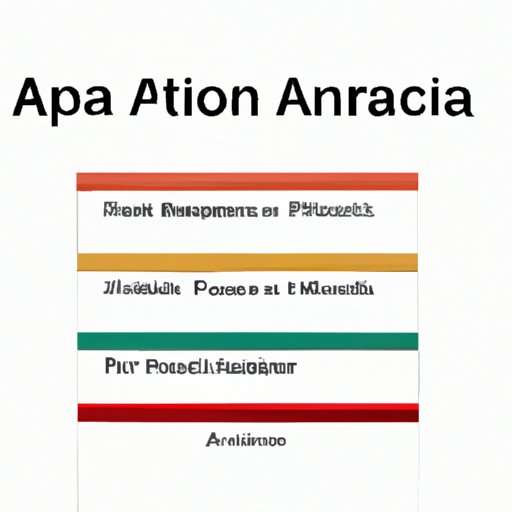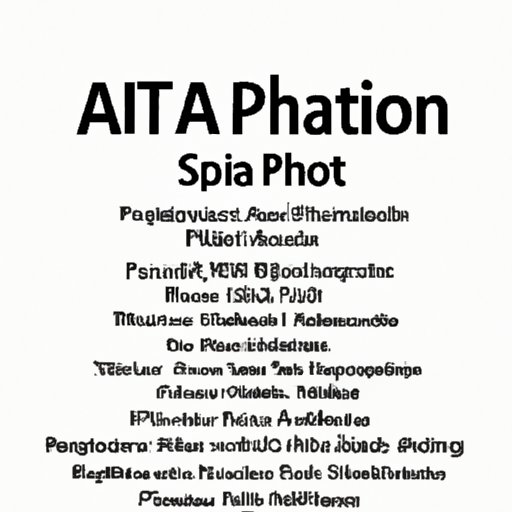
I. Introduction
Citing sources in academic writing is crucial for a few reasons: it gives credit to the original creators of the work and allows readers to track down the sources themselves. One of the most widely used citation styles in academic writing is APA, or American Psychological Association, format. In this article, we will discuss everything you need to know to create APA style citations in your writing.
II. What is APA Format?
APA format is a set of rules and guidelines that govern the style and formatting of research papers and other types of academic writing. The rules provide a framework for authors to properly attribute sources to their original creators and cite their work in the text. APA format is commonly used in the social sciences, business, and education fields.
III. The Basics of APA Citation
The key elements of an APA citation include the author’s name, year of publication, title of the work, publication information, and any relevant page numbers. When creating an APA citation, it is important to follow the specific rules and guidelines for the type of source being cited.
For example, an APA citation for a book should include the following information:
- Author’s Last Name, First Initial. (Year of Publication). Title of Work: Capital Letter Also for Subtitle. Publisher.
While an APA citation for a journal article should include:
- Author’s Last Name, First Initial. (Year of Publication). Title of Article. Title of Journal, Volume number(Issue number), Page range.
When citing a website, the citation should include the author’s name (if available), the date of publication or update, the title or description of the web page, and the URL.
IV. A Step-by-Step Guide to Citing in APA Format
Creating an APA citation can be a daunting task, but it doesn’t have to be. Here is a step-by-step guide to creating an APA citation for a book:
- List the author’s last name and first initial, separated by a comma.
- Include the year of publication in parentheses.
- Provide the title of the book in italics and capitalize the first word of the title and all proper nouns.
- Include the publisher’s name.
- List the DOI or URL if available.
For example:
Doe, J. (2005). Writing 101: A Beginner’s Guide to Academic Writing. Penguin Books. https://doi.org/10.1234/penguinbooks
V. Secrets of APA Citation: Tips and Tricks
Citing sources can be time-consuming and confusing, but there are some insider tips that can make the process easier. Here are a few tips for mastering APA citation:
- Use citation management software like Mendeley or Zotero.
- Double-check your citations for accuracy.
- Put your sources in alphabetical order.
- Italicize book and journal titles, but not article titles.
- Use “et al.” when citing sources with three or more authors.
By following these tips, you can make the process of citing in APA format more efficient and effective.
VI. Mastering APA: A Comprehensive Guide to Citation
While the basics of APA citation have been covered, there are many more rules and guidelines that authors must follow to ensure they are citing correctly. These guidelines include formatting, punctuation, and capitalization rules.
It is important to adhere to these guidelines because failing to do so can result in lower grades on assignments or even accusations of plagiarism. Some common sources of plagiarism include failing to cite a source properly, using a direct quote without citation, and paraphrasing without citation.
To avoid plagiarism, authors must follow the specific rules and guidelines for APA citation. The APA Publication Manual is the authoritative source for these rules and guidelines, and it should be consulted whenever you are unsure about how to format a citation.
VII. Breaking Down APA Format: DIY Citation Made Easy
If you’re looking for a simpler way to create APA citations, follow these steps:
- Find the author’s name, publication date, and title of the source you want to cite.
- Choose the type of source you are citing (e.g. book, article, website).
- Use an automated citation generator like Citation Machine or EasyBib.
- Double-check your citation for accuracy.
While these tools can be helpful, it is important to check the citation for accuracy and to ensure it follows the specific rules and guidelines for APA citation.

VIII. The Ultimate Cheat Sheet for APA Citations
If you want a quick reference guide to APA citations, use this cheat sheet:
- List authors in the order they appear on the source.
- Use an Oxford comma.
- Italicize book and journal titles.
- Capitalize only the first word of a title and subtitle, proper nouns, and acronyms.
- Include the DOI or URL if available.
These guidelines apply to book, journal, and website sources. Remember to consult the APA Publication Manual for more specific rules and guidelines for each type of source.
IX. Simplifying APA Citation: How to Navigate the Rules
APA citation can be challenging, but there are some strategies for navigating the rules. Here are a few common challenges and solutions for creating APA citations:
- Missing Information: If you are missing information for a citation, use “n.d.” for “no date” or “n.p.” for “no publisher.”
- Multiple Authors: Use “et al.” when citing sources with three or more authors.
- Multiple Sources: If you are citing multiple sources within the same citation, separate them with a semicolon.
By knowing how to solve common citation challenges, authors can navigate the rules and guidelines for APA citation more easily.
X. Conclusion
In this article, we covered everything you need to know to cite sources in APA format. From the basics to insider tips and tricks, we provided a comprehensive guide to creating proper citations in your papers. Remember, citing sources in academic writing is crucial for giving credit to the original creators and allowing readers to track down the sources themselves. By taking the information learned here and applying it to your own writing, you can become a master of APA citation.





